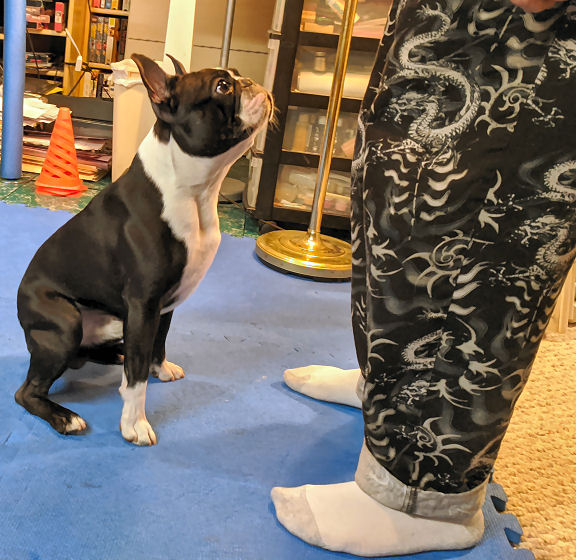What an odd thing to say! Of course dogs can’t use forks. Why is that relevant for dog training?
It came up the other day when a new student of ours asked “Why does my dog know this stuff at home and not here?” (Patience, we’re getting to the forks part.)
It’s a good question, and one that addresses a fundamental difference between the way people think and the way dogs think. People generalize. Dogs don’t.
What does that mean? Basically it’s that your dog knows “Sit!” in the kitchen at home with you facing him/her and holding a treat. It’s knowledge in context, with a specific set of conditions. Change the conditions, and the knowledge isn’t there. Try it outside, or at training class, and your dog has no clue what the word “Sit!” means.
For people, it’s different. (Here come the forks!) Once you know how to use a fork, you know how to use every fork in the world, regardless of where you are, what the fork is made of, or what it looks like. A fork with only two tines? No problem. Plastic, bamboo, or metal? Not an issue. Your knowledge of “fork” expands to include all forks, everywhere.
Getting past the problem

The solution is to vary your training so that your dog learns to generalize. Randomly, wherever you are, tell your dog to “Sit!” And be prepared to reward when he/she does. If your dog doesn’t sit – just wait. Give them time to think and process. “We’re not in the kitchen, but the sound she’s making is familiar, and her hand up like that means she has a cookie.” Give the message time to make its way from your dog’s brain to their hindquarters. Be patient. And reward generously for success.
Just because your dog doesn’t, by nature, generalize doesn’t mean they can’t. But creating new ways of thinking takes some time and consistency. And the skill, once it’s attained, has to be practiced. Every command your dog learns has to expand in range.
It sounds like a lot of time and effort, but it’s really not. Once your dog gets with the program, it’s easy and fun to try. Yesterday, while Fran and Simon were waiting around for Novice Obedience class to start, she gave him the “Troll!” command (from “Front!” the dog goes around to your right and goes between your legs, looking up at you). And he did it! Even though he’d never done it in that place before.
Expand their horizons
One of the beauty parts of the 2-Minute Trainer method is that you can always back up. If your dog’s understanding of something is “iffy” in new circumstances, just go back as far as you need to. Whatever steps you took to teach the dog in the first place can be recreated. Your dog will most likely remember quickly: “Oh, I remember that now!”
When you build a firm foundation for your dog’s learning, it’s not just easier to teach them to generalize. It also opens the pathways for learning new things and building on known skills. Creating variations of games also helps. For example: if you teach your dog to retrieve an Obedience dumbbell, what happens if you place it on the floor at a distance instead of throwing it? What if the dumbbell is on end, instead of on its side? Or if, instead of dropping it, you ask your dog to carry it while heeling?
Teach dogs to use every fork
Practically speaking, dogs who absolutely know what they’re supposed to be doing will do it when asked, anytime, anywhere. Another example is the “Figure 8” obedience exercise. Most people train the exercise as it’s performed in competition: heel around two cones, crossing in the center, then halt. Then do it again.
Training only the exercise as it’s required in competition means that the dogs are pattern trained. They can do the exercise all by themselves without their person. They don’t understand that it’s about paying attention to their person and heeling together as a team. The goal should be building your teamwork, not the mechanics of the exercise.
Instead of the “real” exercise; put out three cones, or four. Go any which way, asking your dog to stay with you. If they don’t know where you’re going, they have to pay attention. Another variation on the behavior that grows your dog’s understanding.
Generally speaking
The joy and challenge of dog training is to build your dog’s understanding. When you see your dog “get” something you’ve been teaching, the feeling of pride, for both of you, is exhilarating. It may take patience to get there, but it’s worth it.






